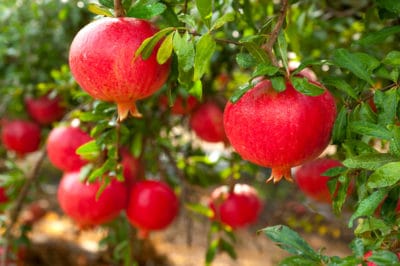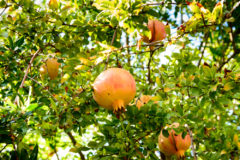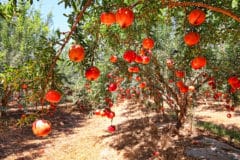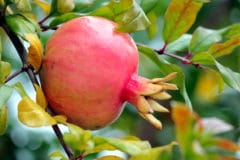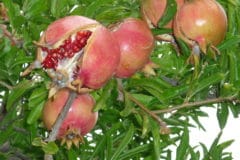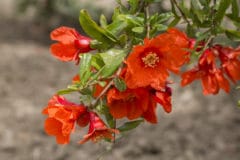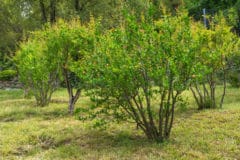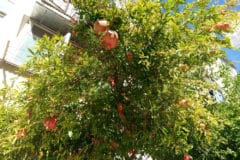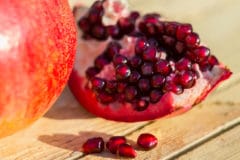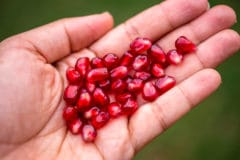About the Pomegranate
The pomegranate is a small tree or shrub, rarely more than 30 feet tall. Deciduous, it bears bright red flowers in spring and red, hard-shelled fruits in fall. The fruits are composed of clusters of individual arils with juicy tart-sweet flesh surrounded by a thin membrane and encasing a seed. Seeds are eaten raw, cooked or dried and the fruit may be juiced.
Pomegranate Varieties
There are only two forms of pomegranate: Punica granatum and Punica protopunica. The former has more than 500 named cultivars although Wonderful is the variety most often grown in the US. Varieties include:
- Ariana
- Desertnyi
- Francis
- Granada
- Kashmir Blend
- Parfianka
- Sienevyi
- Sweet
- Wonderful
Soils for Pomegranates
Pomegranates are highly adaptable and grow in a wide range of soils. They do best in neutral to slightly acidic soil with a pH range of 5.5 to 7. However, they will grow in acidic sandy loams and alkaline calcareous soils or even – as in common in India – rocky gravel. However, they will not do well in heavy clay unless it is heavily amended to promote good drainage.
USDA Zones
Native to dry, hot areas, pomegranates typically do best in USDA Zones 8 to 10. However, some varieties are more frost hardy and can be grown in Zone 7B, with winter temperatures as low as 5 °F (-14.9 °C). Others will do well in the warmer area of Zone 11. Hard-seeded varieties are typically more cold hardy than soft-seeded varieties.
Around the World
Pomegranates have expanded well beyond their original range in what is now Iran. Moving first through Afghanistan and Pakistan to northern India, they made their way into Spain. Spanish explorers took them to America in the 16th century and the trees did very well in California. Pomegranates are cultivated in the Middle East, drier areas of southeast Asia and the Mediterranean.
Major Pomegranate Producers
India is the world’s leading commercial pomegranate producer and growers are able to produce fruit year round. Iran, the pomegranate’s original home, is the second largest producer. In addition to India and Iran, Afghanistan, Morocco, Spain and Turkey produce high-quality fruit. Other countries where pomegranates are grown commercially include Tunisia, China, Greece, Japan, France, Armenia, Cyprus, Egypt, Italy, Palestine and the US.
US States for Pomegranates
California is the leading commercial producer of pomegranates in the US. Tulare, Fresno and Kern counties have the largest pomegranate orchards, although there are also smaller plantings in Imperial and Riverside counties. Pomegranates are also grown in Arizona and Texas. Although Spanish Ruby and Sweet Fruited were historically the leading varieties in California, they were superseded by Wonderful. Grenada is now becoming the most popular variety.
Pomegranates in the Garden
If you live in a USDA Zone where pomegranates can be grown, your primary consideration is soil. Native to dry regions and drought tolerant, pomegranates must have well-drained soil. Either amend the soil with coarse sand and/or use raised beds to ensure adequate drainage. Plant the tree in full sun and don’t crowd with other plants. Irrigation is usually unnecessary.
Pomegranates in Containers
Choose one of the smaller varieties such as Eversweet, Pink Satin or Sweet. Pomegranates must have a 10-gallon or larger container. Potting soil with the addition of coarse builder’s sand and a pot with adequate drainage will help prevent root rot. Water deeply once a week. Fertilize with an organic 10-10-10 fertilizer in November, February and May for the first two years, then in only in November and February.
Pomegranates Indoors
If you live in a cold climate, you can still grow pomegranates indoors. Choose a dwarf variety such as Punica granatum ‘Nana.’ Your pomegranate must have well-drained soil – be careful not to over-water. Place the plant in a southern or eastern exposure for maximum light. Indoor nighttime temperatures should range from 50 to 60°F (10 to 16°C) in the growing season and 40 to 45°F (4 to 7°C) in winter.
